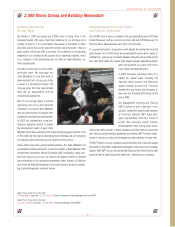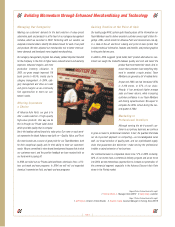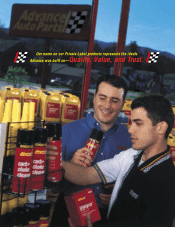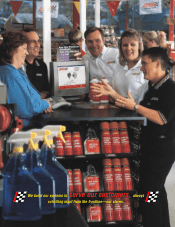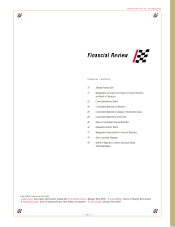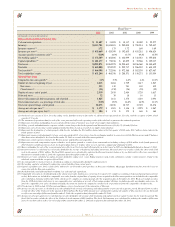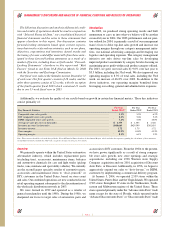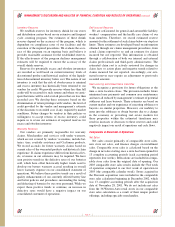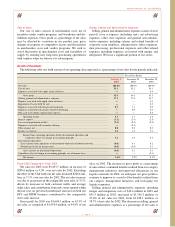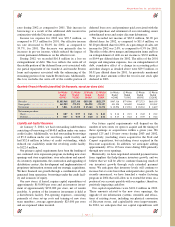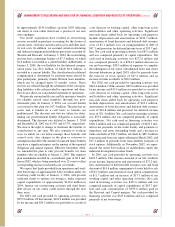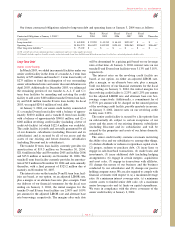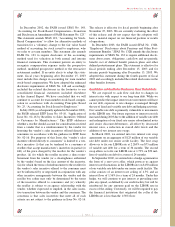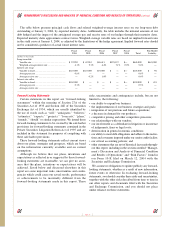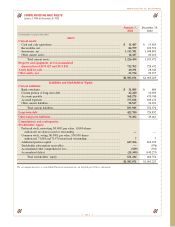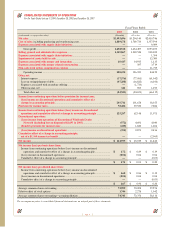Advance Auto Parts 2003 Annual Report Download - page 16
Download and view the complete annual report
Please find page 16 of the 2003 Advance Auto Parts annual report below. You can navigate through the pages in the report by either clicking on the pages listed below, or by using the keyword search tool below to find specific information within the annual report.
Inventory Reserves
We establish reserves for inventory shrink for our stores
and distribution centers based on our extensive and frequent
cycle counting program. Our estimates of these shrink
reserves depend on the accuracy of the program, which is
dependent on compliance rates of our facilities and the
execution of the required procedures. We evaluate the accu-
racy of this program on an ongoing basis and believe it
provides reasonable assurance for the established reserves.
If the effectiveness of the program declines management
estimates will be required to ensure the accuracy of the
overall shrink reserves.
Reserves for potentially excess and obsolete inventories
are recorded as well based on current inventory levels of
discontinued product and historical analysis of the liquida-
tion of discontinued inventory below cost. The nature of our
inventory is such that the risk of obsolescence is minimal
and excess inventory has historically been returned to our
vendors for credit. We provide reserves where less than full
credit will be received for such returns and where we antic-
ipate that items will be sold at retail prices that are less than
recorded cost. We develop these estimates based on the
determination of return privileges with vendors, the level of
credit provided by the vendor and management’s estimate
of the discounts to recorded cost, if any, required by market
conditions. Future changes by vendors in their policies or
willingness to accept returns of excess inventory could
require us to revise our estimates of required reserves for
excess and obsolete inventory.
Warranty Reserves
Our vendors are primarily responsible for warranty
claims. Merchandise and services sold under warranty,
which are not covered by vendors’ warranties, include bat-
teries, tires, roadside assistance and Craftsman products.
We record accruals for future warranty claims based on
current sales of the warranted products and historical claim
experience. If claims experience differs from historical lev-
els, revisions in our estimates may be required. We have
seen positive trends in the defective rates of our batteries
sold, which have offset historically higher trends used to
develop our battery warranty accrual resulting in overall
lower warranty expense on our consolidated statement of
operations. We believe these positive trends are a result of
quality enhancements of our currently offered battery line
and better policies and procedures surrounding the testing
and defecting of batteries by our store personnel. While we
expect these positive trends to continue, an increase in
defective rates would have a negative impact on our
consolidated statement of operations.
Self-Insured Reserves
We are self-insured for general and automobile liability,
workers’ compensation and the health care claims of our
team members. Therefore, we record estimated reserve
amounts for the settlement of such claims below our stop-loss
limits. These estimates are developed based on information
obtained through our claims management procedures, from
actual claims reported to us and an estimate for claims
incurred but not reported. This information is obtained
through a collaboration of both our internal and external
claims professionals and third-party administrators. The
estimated claim cost is actively reviewed for changes in
claim facts or action plans and negative trends related to
claims incurred but not reported. Accordingly, our esti-
mated reserves may require an adjustment to previously
recorded amounts.
Restructuring and Closed Store Liabilities
We recognize a provision for future obligations at the
time a store location closes. The provision includes future
minimum lease payments and common area maintenance
and taxes all reduced by management’s estimate of potential
subleases and lease buyouts. These estimates are based on
current market and our experience of executing subleases or
buyouts on similar properties. However, our inability to
enter into the subleases or obtain buyouts due to a change
in the economy or prevailing real estate markets for
these properties within the estimated timeframe may
result in increases or decreases to these reserves and could
negatively impact our result of operations and cash flows.
Components of Statement of Operations
Net Sales
Net sales consist primarily of comparable store sales,
new store net sales, and finance charges on installment
sales. Comparable store sales is calculated based on the
change in net sales starting once a store has been opened for
13 complete accounting periods (each accounting period
represents four weeks). Relocations are included in compa-
rable store sales from the original date of opening. Our
2003 comparable store sales results include the 53rd week
of operation compared to our first week of operation in
2003 (the comparable calendar week). Stores acquired in
the Discount acquisition were included in the comparable
store sales calculation beginning in December 2002, which
was 13 complete accounting periods after the acquisition
date of November 28, 2001. We do not include net sales
from the 36 Western Auto retail stores in our comparable
store sales calculation as a result of their unique product
offerings, including specialty merchandise.
MANAGEMENT’S DISCUSSION AND ANALYSIS OF FINANCIAL CONDITION AND RESULTS OF OPERATIONS (continued)
Page 14



